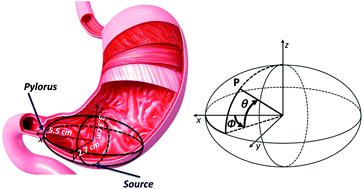当前位置:
X-MOL 学术
›
Photochem. Photobiol. Sci.
›
论文详情
Our official English website, www.x-mol.net, welcomes your feedback! (Note: you will need to create a separate account there.)
Influence of stomach mucosa tissue on the efficacy of intragastric antibacterial PDT.
Photochemical & Photobiological Sciences ( IF 3.1 ) Pub Date : 2019-11-22 , DOI: 10.1039/c9pp00315k A Gnerucci 1 , P Faraoni 1 , S Calusi 1 , F Fusi 1 , G Romano 1
Photochemical & Photobiological Sciences ( IF 3.1 ) Pub Date : 2019-11-22 , DOI: 10.1039/c9pp00315k A Gnerucci 1 , P Faraoni 1 , S Calusi 1 , F Fusi 1 , G Romano 1
Affiliation

|
In the field of photodynamic therapy (PDT), optimization of the in vivo therapeutic efficacy needs a comprehensive study of the photo-killing action spectrum that depends on both the photosensitizer (PS) absorption and the tissue optical properties. This is especially true in the case of gastric infections by Helicobacter pylori: PS absorption has been largely investigated in vitro, while the contribution of tissue optical properties and illumination geometry has been poorly studied, despite being parameters that reflect the specific in vivo conditions. To investigate their influence, we focussed on the case of a point-like light source positioned in the antrum. This models a therapeutic device developed by our team which consists of a LED-based ingestible pill. By a simple 3D illumination model, our approach mediates light–tissue interaction over the illuminated stomach wall surface, then calculates its average transmittance T by means of a 1D model representative of the mean gastric mucosa structure. Finally, by merging T(λ) with the photosensitizers’ absorption we obtained the in vivo action spectrum. This shows two peaks at about 500 and 630 nm, indicating a noticeable influence of the tissue with respect to in vitro studies, where the action spectrum reflects PS absorption only. Our approach defines one average action spectrum for this specific therapeutic context, which reflects the need to choose one emission spectrum for the light source used. The proposed methodology could be applied to any other illumination geometry of cave organs, provided appropriate model modifications for the light source and tissue characteristics are made.
中文翻译:

胃粘膜组织对胃内抗菌PDT疗效的影响。
在光动力疗法(PDT)领域,体内治疗功效的优化需要对光杀死作用谱进行全面研究,该谱既取决于光敏剂(PS)的吸收,又取决于组织的光学性质。在幽门螺杆菌引起的胃部感染情况下尤其如此:PS吸收已在体外进行了广泛研究,而组织光学特性和照明几何形状的贡献却很少得到研究,尽管这些参数反映了体内的特异性。情况。为了研究它们的影响,我们重点研究了位于腔体内的点状光源的情况。这将模拟由我们团队开发的治疗设备,该治疗设备由基于LED的可吸收药丸组成。通过一个简单的3D照明模型,我们的方法在被照明的胃壁表面上介导了光与组织的相互作用,然后通过代表平均胃粘膜结构的1D模型来计算其平均透射率T。最后,通过将T(λ)与光敏剂的吸收合并,我们获得了体内作用谱。这在约500和630 nm处显示两个峰,表明该组织相对于体外有明显的影响研究表明,作用谱仅反映PS吸收。我们的方法为这种特定的治疗环境定义了一个平均作用谱,这反映了需要为所使用的光源选择一个发射谱。如果对光源和组织特征进行了适当的模型修改,则所提出的方法可以应用于洞穴器官的任何其他照明几何形状。
更新日期:2019-11-22
中文翻译:

胃粘膜组织对胃内抗菌PDT疗效的影响。
在光动力疗法(PDT)领域,体内治疗功效的优化需要对光杀死作用谱进行全面研究,该谱既取决于光敏剂(PS)的吸收,又取决于组织的光学性质。在幽门螺杆菌引起的胃部感染情况下尤其如此:PS吸收已在体外进行了广泛研究,而组织光学特性和照明几何形状的贡献却很少得到研究,尽管这些参数反映了体内的特异性。情况。为了研究它们的影响,我们重点研究了位于腔体内的点状光源的情况。这将模拟由我们团队开发的治疗设备,该治疗设备由基于LED的可吸收药丸组成。通过一个简单的3D照明模型,我们的方法在被照明的胃壁表面上介导了光与组织的相互作用,然后通过代表平均胃粘膜结构的1D模型来计算其平均透射率T。最后,通过将T(λ)与光敏剂的吸收合并,我们获得了体内作用谱。这在约500和630 nm处显示两个峰,表明该组织相对于体外有明显的影响研究表明,作用谱仅反映PS吸收。我们的方法为这种特定的治疗环境定义了一个平均作用谱,这反映了需要为所使用的光源选择一个发射谱。如果对光源和组织特征进行了适当的模型修改,则所提出的方法可以应用于洞穴器官的任何其他照明几何形状。


























 京公网安备 11010802027423号
京公网安备 11010802027423号